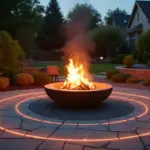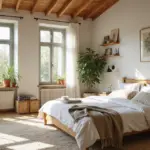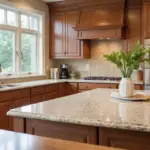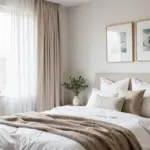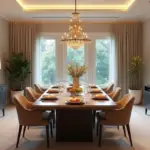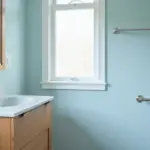Stepping into a vintage bathroom is like opening a time capsule filled with character, charm, and craftsmanship rarely found in today’s mass-produced designs. As someone who spends her days integrating artistic spaces with living areas, I’ve found that bathrooms offer one of the most delightful canvases for expressing vintage aesthetics while maintaining modern functionality.
The beauty of vintage bathroom design lies in its ability to transport us to another era while still serving our contemporary needs. Whether you’re drawn to the glamour of Art Deco, the simplicity of mid-century modern, or the warmth of farmhouse vintage, there’s a world of inspiration waiting to transform your bathroom into a sanctuary of timeless style.
But here’s the thing – creating an authentic vintage bathroom isn’t about haphazardly throwing together old-fashioned elements. It’s about understanding the subtle design language of past eras and translating it thoughtfully into your space. Let’s explore 23 vintage bathroom design ideas that capture the essence of bygone days while creating spaces you’ll love for years to come.
1. Embrace the Iconic Clawfoot Tub
Nothing says “vintage bathroom” quite like a clawfoot tub. These freestanding beauties aren’t just bathtubs – they’re sculptural centerpieces that instantly elevate a bathroom from ordinary to extraordinary. Available in several styles including roll-top, slipper, and double-ended varieties, clawfoot tubs offer both visual drama and practical comfort.

When selecting a clawfoot tub for your space, consider both aesthetic preferences and practical constraints. Measure your bathroom carefully, accounting for door swings and traffic flow. Cast iron tubs filled with water can be extraordinarily heavy, so ensure your floor can support the weight, especially in older homes where structural reinforcement might be necessary.
“For an unexpected twist, paint the clawfeet in a contrasting color like gold or matte black – this simple detail transforms a classic piece into a personal statement that honors tradition while adding a contemporary edge.”
The key thing to understand is that your tub will set the tone for the entire bathroom, so choose a style that resonates with your overall vision. With this centerpiece established, we can move on to another quintessential vintage fixture that perfectly complements the elegant simplicity of a clawfoot tub.
2. Opt for Classic Pedestal Sinks
Pedestal sinks are the ballet dancers of vintage bathroom design – graceful, elegant, and seemingly defying gravity with their slender supports. These space-saving fixtures create an airy, open feeling that’s particularly valuable in smaller vintage bathrooms where bulky vanities might overwhelm the space.

What makes pedestal sinks particularly special is how they showcase your bathroom’s flooring. Without cabinets blocking the view, decorative tile patterns become more prominent, creating a cohesive visual flow throughout the room. Though they offer minimal storage compared to vanities, their visual lightness and authentic period appeal make them worth considering for true vintage enthusiasts.
- Look for models with small built-in soap ledges or integrated towel bars for added functionality
- Pair with wall-mounted storage solutions like medicine cabinets or open shelving
- Consider models with decorative details on the basin and pedestal for added character
When it comes to choosing the right pedestal sink, the process goes like this: measure your space carefully, ensure your plumbing configuration is compatible (floor-mounted drains work best), and select a design that complements your overall aesthetic. Now that we’ve established our key fixtures, let’s look at one of the most versatile and timeless surface treatments for vintage bathroom walls.
3. Install Timeless Subway Tiles
Subway tiles have been gracing bathroom walls for over a century, and for good reason. Their simple rectangular shape, slightly beveled edges, and glossy finish create a clean, timeless look that works with virtually any vintage bathroom style – from Victorian to Art Deco to mid-century modern.

What many people overlook is the incredible versatility of subway tiles beyond the classic white. From soft pastels to bold jewel tones, matte finishes to high gloss, and various layout patterns like herringbone or vertical stacks, these tiles can completely transform based on your design choices. The grout color alone can dramatically change the look – dark grout emphasizes the pattern and hides staining, while matching grout creates a more seamless appearance.
- Classic applications: Shower surrounds, backsplashes, wainscoting
- Creative layouts: Herringbone, vertical stack, basketweave
- Color combinations: White tiles with dark grout, colored tiles with white grout
The surprising part is that these seemingly simple tiles can be arranged in countless ways to create unique patterns that add visual interest while maintaining the authentic vintage feel. As we move from the walls to the floor, there’s another classic tile option that perfectly complements the clean lines of subway tile.
4. Lay Down Charming Hexagon Floor Tiles
Hexagon tiles are to vintage bathroom floors what subway tiles are to walls – utterly timeless. Popular in bathrooms from the early 1900s through the 1950s, these six-sided tiles create a distinctive honeycomb pattern that adds instant character and authentic period charm to any vintage bathroom design.

The classic black and white combination remains perennially popular, but don’t limit yourself. Soft pastels like mint green, pale pink, or light blue can create a delightfully retro feel, while muted earth tones offer a more subtle approach. For true vintage authenticity, consider tiny hexagon mosaics (often called “penny tiles”) with occasional accent colors creating simple floral or geometric patterns.
- Size options: From tiny penny tile mosaics to larger 4-6″ hexagons
- Pattern possibilities: Solid colors, borders, scattered accent tiles, geometric designs
- Color combinations: Classic black and white, pastels, earth tones
The heart of the matter is that your floor sets the foundation for your entire vintage bathroom. With this distinctive pattern established, your eye naturally travels upward to the fixtures that add the finishing touch to your vintage vision.
5. Choose Vintage-Inspired Faucets and Fixtures
Faucets and fixtures are the jewelry of your vintage bathroom design – they may be smaller elements, but they pack a powerful punch in establishing authentic period style. The right vintage-inspired hardware can transform even modern elements into something that feels genuinely from another era.

This is where everything changes from utilitarian to special. Cross-handle faucets with porcelain indicators for hot and cold water, bridge faucets with gooseneck spouts, telephone-style shower fixtures – these distinctive designs connect us directly to the past. Finishes matter tremendously here too. While gleaming chrome dominated mid-century bathrooms, older styles often featured brass, bronze, or nickel with varying levels of polish or patina.
- Popular vintage faucet styles: Cross-handles, bridge faucets, gooseneck spouts
- Classic finishes: Polished chrome, brushed nickel, oil-rubbed bronze, polished brass
- Don’t forget: Shower fixtures, towel bars, robe hooks, and toilet handles
Let me show you another perspective – while modern fixtures prioritize water efficiency and ease of cleaning, vintage-inspired options balance these practical concerns with distinctive details that celebrate the craftsmanship of the past. Speaking of celebrating the past, let’s look at how a special mirror can become the focal point of your vintage bathroom.
6. Hang an Ornate Antique Mirror
An ornate antique mirror does far more than just reflect your image – it reflects the soul of your vintage bathroom design. Whether you choose an authentic period piece or a quality reproduction, an ornate mirror adds instant character, visual interest, and a touch of luxury to your space.

Picture this instead: rather than the plain rectangular mirrors found in most modern bathrooms, imagine a gilded frame with intricate carvings, a beveled glass edge that catches and plays with light, or an aged patina that speaks of decades of gentle use. This single element creates a focal point that elevates the entire room, especially when paired with well-chosen lighting to highlight its beauty.
- Mirror placement: Above pedestal sinks, vanities, or as standalone decorative elements
- Style options: Victorian gilt frames, Art Deco geometrics, rustic wood frames
- Special features: Beveled edges, etched details, aged patina
The crucial point is that your mirror serves as both a functional necessity and a defining stylistic element. With the right vintage mirror in place, proper lighting becomes the next essential consideration to showcase your bathroom’s beauty.
7. Illuminate with Retro Sconce Lighting
Lighting transforms a vintage bathroom from merely looking period-appropriate to actually feeling like a space from another era. Wall sconces in particular were a hallmark of vintage bathroom design, providing flattering, shadow-free illumination that modern overhead lighting simply can’t match.

The underlying principle is that lighting should be both beautiful and functional. Vintage-inspired sconces with frosted or etched glass shades diffuse light softly across the face – ideal for grooming tasks – while adding architectural interest to the walls. Consider placing pairs of matching sconces flanking your mirror for the most flattering light, or use them strategically throughout the bathroom to eliminate dark corners and create a warm, inviting ambiance.
- Popular vintage styles: Art Deco with geometric patterns, Victorian with etched glass, industrial with exposed bulbs
- Placement options: Flanking mirrors, alongside tubs, highlighting architectural features
- Practical considerations: Proper electrical installation, appropriate bulb temperature (warm vs. cool)
Now, I know what you’re thinking – fixtures and finishes are important, but what about adding texture and architectural interest to my bathroom walls? That’s exactly where our next vintage bathroom design element comes into play.
8. Add Texture with Beadboard Paneling
Beadboard paneling brings subtle texture, traditional charm, and architectural integrity to vintage bathroom walls. This classic wall treatment features narrow vertical boards with rounded ridges between them, creating a pattern of gentle shadows and highlights that adds dimension without overwhelming the space.

The breakthrough came when homeowners realized beadboard could be installed just partially up the wall as wainscoting, typically 32-42 inches high, with paint or wallpaper above. This combination creates visual interest through contrasting textures and colors while protecting lower walls from moisture and wear. In vintage bathrooms, white beadboard paired with soft pastel walls above creates a quintessentially charming look that works beautifully with virtually any vintage style from Victorian to cottage to early 20th century.
- Installation options: Full wall coverage or wainscoting height
- Finish choices: Painted (typically semi-gloss for moisture resistance), natural wood (properly sealed)
- Complementary elements: Chair rail molding at the top edge, decorative baseboards
What’s fascinating is how this relatively simple wall treatment can completely transform the character of a bathroom, establishing a distinctly vintage feel even when paired with more modern fixtures. But if you’re looking for an even more dramatic wall treatment that makes a bold vintage statement, you’ll want to consider our next design idea.
9. Go Bold with Vintage Patterned Wallpaper
Wallpaper in vintage bathroom design isn’t just a wall covering – it’s a statement piece that can define the entire mood of your space. From delicate florals reminiscent of Victorian gardens to bold geometric patterns from the Art Deco era, vintage-inspired wallpaper creates instant character and period authenticity.

The real story begins when you consider the dramatic transformation wallpaper can achieve. A small powder room can become a jewel box of pattern and color, while a larger bathroom might feature wallpaper in select areas to create focal points. Modern moisture-resistant wallpapers have made this once-risky bathroom choice far more practical, allowing today’s homeowners to embrace patterns with confidence.
- Popular vintage patterns: Florals, damasks, toile de Jouy, geometric Art Deco designs
- Application considerations: Full room, accent wall, above wainscoting
- Moisture management: Choose vinyl wallpaper for shower-adjacent areas, ensure proper ventilation
This changes everything though – when you introduce bold pattern to your vintage bathroom walls, your color choices become even more crucial to maintain balance and cohesion. Let’s explore how the right color palette can enhance your vintage bathroom design.
10. Paint with Soft Pastel Color Palettes
Soft pastel colors are the secret language of vintage bathroom design, speaking volumes about the era you’re channeling. Mint green, pale pink, powder blue, and lavender weren’t just random color choices in mid-century and earlier bathrooms – they were deliberate design decisions that created specific moods and complemented the materials of the time.

The breakthrough came when designers realized these gentle hues could create a light, uplifting atmosphere in spaces that were often small and lacking natural light. Today’s vintage bathroom enthusiasts can leverage this knowledge, using historically accurate color palettes to evoke specific periods. A pale pink and black bathroom immediately suggests the 1950s, while sage green paired with white feels distinctly 1930s.
- Classic pastel combinations: Mint green and black, pink and burgundy, pale blue and white
- Application strategies: Dominant wall color with complementary trim, fixtures, and textiles
- Modern twists: Using a darker, more saturated version of a pastel for accent walls or cabinetry
What’s fascinating about color in vintage bathroom design is how it can instantly signal a specific decade or style period. But for those who prefer a more timeless, high-contrast approach, our next vintage bathroom idea offers a sophisticated alternative.
11. Create Contrast with Black and White Schemes
Black and white is the eternal power couple of vintage bathroom design – a pairing that transcends specific eras while still feeling authentically nostalgic. This high-contrast combination delivers dramatic visual impact while providing a neutral foundation that works with any accent color you might wish to introduce.

Let me break this down: black and white bathrooms tap into design traditions spanning from Victorian to Art Deco to mid-century modern. The key to success lies in the balance – typically using white as the dominant color for walls and larger fixtures, with black providing definition, contrast, and visual weight. The classic checkerboard floor is just the beginning; consider black accents on mirror frames, lighting fixtures, hardware, and trim to create a cohesive, sophisticated look.
- Signature elements: Checkerboard floors, white subway tile with dark grout, black trim
- Balance considerations: Typically 70-80% white with 20-30% black for classic vintage feel
- Accent opportunities: Introduce single color accents (red, yellow, green) for specific period references
The key factor here is that black and white creates a timeless foundation that can be accessorized differently as your tastes evolve. For those seeking to add warmth and character to their vintage bathroom, our next idea introduces furniture-inspired elements that soften the sometimes clinical feel of traditional bathroom fixtures.
12. Select a Furniture-Style Vintage Vanity
Furniture-style vanities bring the warmth and character of real furniture into the bathroom, creating a less utilitarian, more personalized vintage feel. Unlike built-in cabinets, these standalone pieces resemble antique dressers or sideboards, complete with turned legs, carved details, and furniture-quality hardware.

It all comes down to this – a furniture-style vanity serves as a bridge between bathroom function and living space comfort. It softens the clinical feel of a bathroom while providing practical storage and counter space. The beauty of this approach lies in the unique character each piece brings – whether you choose a reproduction designed specifically as a vanity or repurpose an actual antique piece adapted for plumbing.
- Style options: Victorian with ornate details, Mid-century with clean lines, Farmhouse with rustic elements
- Material considerations: Solid wood (properly sealed), painted finishes with protective topcoats
- Practical aspects: Height, counter surface water resistance, sink compatibility
Here’s where it gets interesting – while purpose-built furniture-style vanities offer convenience, some of the most distinctive vintage bathroom designs come from thinking outside the box and repurposing actual antique furniture.
13. Repurpose Antique Dressers as Vanities
Repurposing an antique dresser as a bathroom vanity isn’t just a design choice – it’s a storytelling opportunity. Each antique piece brings its own history, craftsmanship, and unique character that mass-produced vanities simply can’t match, instantly making your vintage bathroom design one-of-a-kind.

The surprising part is that this approach can actually be budget-friendly while delivering high-end custom results. Antique dressers, especially those with minor damage that doesn’t affect their structural integrity, can often be found at reasonable prices at estate sales, flea markets, or online marketplaces. With some creative adaptation for plumbing and proper sealing against moisture, these pieces become functional art in your vintage bathroom.
- Ideal candidates: Solid wood construction, dovetailed drawers, quality hardware
- Necessary adaptations: Cutouts for plumbing, sink installation, waterproof sealing
- Style options: Keep original finish for authenticity or paint/refinish to match your color scheme
The driving force behind repurposed vanities is the uniqueness they bring to vintage bathroom design. Speaking of unique approaches, our next idea celebrates elements that most modern bathrooms try to hide.
14. Showcase Exposed Plumbing Details
Exposed plumbing in a vintage bathroom isn’t a flaw – it’s a feature that celebrates the honest functionality and craftsmanship of earlier eras. Copper pipes with their warm glow, brass fixtures developing a living patina, or matte black iron pipes all add industrial character and authentic vintage charm to bathroom designs.

This works something like this: instead of concealing pipes behind walls or under cabinets, vintage-inspired bathrooms can intentionally showcase these elements as part of the decorative scheme. This approach is particularly effective in industrial vintage styles, Victorian designs (where ornate exposed plumbing was actually common), and rustic farmhouse bathrooms where functionality is celebrated rather than hidden.
- Material options: Copper (develops patina), brass (traditional warmth), iron (industrial feel)
- Application areas: Sink plumbing, shower fixtures, tub fillers
- Finish considerations: Polished for formal vintage, matte/aged for industrial or rustic
The essence of it all is that exposed plumbing celebrates rather than hides the functional aspects of a bathroom. Now let’s look at smaller accessories that add vintage character without requiring major renovations.
15. Accessorize with Vintage Soap Dishes and Dispensers
Vintage soap dishes and dispensers may seem like minor details, but they’re the finishing touches that can make a vintage bathroom design feel thoroughly authentic. These small accessories replace generic plastic containers with period-appropriate pieces that contribute to the overall aesthetic narrative.

Here’s how it works: ceramic dishes with delicate patterns, glass dispensers with ornate pump mechanisms, or even metal soap holders with intricate designs all provide opportunities to reinforce your chosen vintage era. Unlike major fixtures or tiles that require significant investment, these small accessories can be changed easily as your style preferences evolve, making them perfect for experimenting with vintage bathroom design elements.
- Material authenticity: Ceramic, porcelain, glass, and metal were common in vintage bathrooms
- Placement opportunities: By sinks, on tub surrounds, on open shelving as decorative elements
- Sourcing options: Antique stores, online vintage marketplaces, reproduction retailers
But what if you’re drawn to a specific design era? Let’s explore how to incorporate one of the most glamorous vintage styles into your bathroom design.
16. Incorporate Art Deco Glamour
Art Deco isn’t just a design style – it’s an entire mood that transforms a bathroom into a sophisticated, glamorous retreat reminiscent of the Roaring Twenties and 1930s Hollywood. With its emphasis on luxurious materials, bold geometric patterns, and sleek lines, Art Deco vintage bathroom design makes a confident statement that still feels remarkably fresh nearly a century later.

Let me paint you a picture of what defines true Art Deco bathroom style: gleaming chrome fixtures, black and white tile in geometric patterns, mirrors with faceted edges, and perhaps touches of gold or rich jewel tones. This style celebrates the machine age with streamlined forms while incorporating exotic influences and rich materials – creating bathrooms that feel simultaneously vintage and timeless.
- Signature elements: Geometric patterns, stepped forms, symmetrical designs
- Material palette: Chrome, black and white tile, mirrors, marble, glass blocks
- Color schemes: Black and white with gold accents, jewel tones like sapphire and emerald
The potential here is enormous – Art Deco brings undeniable glamour to vintage bathroom design. But if your tastes run more toward cozy and rustic rather than sleek and glamorous, our next idea offers a completely different vintage bathroom approach.
17. Infuse Rustic Farmhouse Vintage Touches
Farmhouse vintage brings warmth, comfort, and unpretentious charm to bathroom design. Unlike the glamour of Art Deco or the sleekness of mid-century modern, farmhouse vintage celebrates natural materials, weathered finishes, and practical solutions that feel honest and inviting.

Think of it like this: shiplap walls with their distinctive horizontal lines, reclaimed wood vanities showing the patina of previous lives, and fixtures in oil-rubbed bronze or matte black create a cohesive rustic aesthetic. Farmhouse vintage bathrooms embrace imperfection – a slightly uneven tile edge or variations in wood grain aren’t flaws but features that tell a story of craftsmanship and authenticity.
- Defining elements: Shiplap or beadboard walls, weathered wood, apron-front sinks
- Material palette: Natural wood, galvanized metal, stone, simple ceramics
- Color foundations: Whites, creams, grays with natural wood tones for warmth
Do you see how huge that is? Farmhouse vintage offers a completely different emotional experience than other vintage bathroom styles, yet remains thoroughly authentic to certain periods and regional traditions. As we continue exploring vintage bathroom design, let’s look at practical storage solutions that maintain period charm.
18. Mount a Vintage Medicine Cabinet
A vintage medicine cabinet serves double duty in bathroom design – providing practical storage while reinforcing period authenticity. These wall-mounted or recessed cabinets, typically featuring mirrored doors and often intricate hardware, were standard fixtures in early to mid-20th century bathrooms.

The core reason is that vintage medicine cabinets combine form and function in a way that feels natural to the period. Unlike built-in shelving or modern cabinets that might appear anachronistic, these pieces were genuinely part of vintage bathrooms. Whether you choose an authentic antique or a quality reproduction, a vintage medicine cabinet adds both practical storage and a touch of nostalgia to your bathroom.
- Installation options: Surface-mounted for decorative impact or recessed for a streamlined look
- Style variations: Art Deco with geometric details, Victorian with ornate frames, mid-century with clean lines
- Features to seek: Beveled mirrors, period-appropriate hardware, interior shelving
What complicates this is finding authentic vintage cabinets in good condition, but reproduction options have improved dramatically in recent years. Once the hard surfaces and storage solutions are in place, consider how textiles can further enhance your vintage bathroom’s character.
19. Drape with Linens Featuring Vintage Motifs
Textiles are the unsung heroes of vintage bathroom design – they soften hard surfaces, add color and pattern, and create a sense of comfort and luxury. Towels, shower curtains, window treatments, and bath mats featuring vintage-inspired designs can dramatically enhance the period feel of your bathroom.

Here’s why that happens: vintage bathroom design isn’t just about fixtures and tiles – it’s about creating a complete sensory experience. Textiles with authentic period motifs – whether it’s embroidered floral towels reminiscent of the 1930s, bold geometric patterns inspired by Art Deco, or playful polka dots channeling the 1950s – add layers of visual interest and tactile comfort that make the space feel lived-in and authentic.
- Key textile elements: Towels, shower curtains, window treatments, bath mats
- Vintage motifs: Embroidered details, monograms, florals, geometric patterns, stripes
- Material considerations: Natural fibers like cotton and linen for authenticity
The trick is finding the right balance – too many competing patterns can feel chaotic, while carefully selected textiles can unify your vintage bathroom design. To add another layer of authenticity and life to your space, consider our next suggestion.
20. Decorate with Plants in Vintage-Style Pots
Plants have been bathroom companions since Victorian times, adding life, color, and improved air quality to these intimate spaces. When displayed in vintage-style containers, they become the perfect finishing touch for vintage bathroom design, connecting us to traditions of bringing nature indoors that span generations.

This reminds me of how Victorians embraced indoor gardening with particular enthusiasm, filling their homes with ferns and palms in decorative pots and stands. Modern vintage bathroom enthusiasts can channel this tradition by selecting humidity-loving plants like ferns, pothos, or peace lilies and displaying them in containers that reflect their chosen era – from ornate ceramic pots for Victorian styles to sleek planters for mid-century looks.
- Bathroom-friendly plant options: Ferns, pothos, spider plants, peace lilies
- Container styles: Ceramic with period-appropriate glazes and patterns, brass planters, woven baskets
- Placement ideas: On window sills, atop toilet tanks, on open shelving, or alongside sinks
The missing piece is often the living elements that make a space feel complete. While vintage bathroom design pays homage to the past, it should still feel vibrant and alive. Now let’s focus on a major design element that can dramatically impact the look and feel of your vintage bathroom.
21. Choose a Vintage-Inspired Shower Curtain
A shower curtain in a vintage bathroom is more than a practical necessity – it’s an expansive canvas for expressing your chosen era and style. As one of the largest textile elements in the room, it can anchor your design, introduce pattern and color, and set the overall mood of your vintage bathroom.

Let me walk you through the options: fabric shower curtains with ruffles and tassels evoke Victorian luxury, while those with bold geometric patterns channel Art Deco glamour. Floral prints can reference various eras depending on scale and color – large cabbage roses for Victorian, smaller sprigs for 1930s, and stylized blooms for mid-century. Whatever your vintage vision, there’s likely a shower curtain design that can help bring it to life.
- Material considerations: Fabric for authenticity (with liner for protection)
- Style-specific details: Ruffles (Victorian), geometric patterns (Art Deco), abstract designs (mid-century)
- Practical aspects: Proper sizing, water resistance, ease of cleaning
The ripple effects are enormous when you select the right shower curtain – it can tie together your entire vintage bathroom design scheme. For those seeking ultimate vintage authenticity, consider one more significant fixture that’s often overlooked.
22. Consider a High-Tank or Vintage-Look Toilet
The toilet isn’t typically considered a decorative element, but in vintage bathroom design, it presents an opportunity to enhance period authenticity. High-tank toilets with their elevated water tanks and pull-chain mechanisms were standard in early 20th-century bathrooms and make a distinctive architectural statement.

Here’s the catch: authentic high-tank toilets require specific plumbing considerations and can be more complicated to install than standard models. For those seeking the look without the complications, many manufacturers now offer vintage-inspired toilets with standard tank heights but period-appropriate styling, including details like exposed flush mechanisms, decorative tanks, and wooden seats.
- High-tank considerations: Installation requirements, pull-chain mechanisms, vertical space needs
- Vintage-look alternatives: Period-appropriate styling with modern functionality
- Details that matter: Wooden seats, decorative flush levers, ornate tank designs
Let me explain why this matters – while a standard modern toilet can certainly function in a vintage bathroom, a period-appropriate model completes the historical narrative in a way few other elements can. For those who appreciate vintage style but aren’t purists, our final idea offers a perfect compromise.
23. Mix Vintage Elements with Modern Accents
The most livable and personally expressive vintage bathrooms often blend period charm with modern functionality and contemporary touches. This approach allows you to honor the past while acknowledging present-day needs and your individual aesthetic preferences.

Picture it this way: a classic clawfoot tub paired with sleek modern faucets, subway tile walls alongside a floating vanity, or vintage-style sconces flanking a minimalist mirror. These juxtapositions create dynamic tension and visual interest, preventing your vintage bathroom from feeling like a museum installation while still capturing the charm of bygone eras.
- Successful combinations: Vintage fixtures with modern hardware, traditional materials with contemporary forms
- Balance considerations: Maintaining cohesion through consistent color scheme or material palette
- Personal expression: Incorporating modern art or accessories that speak to your individual style
This could revolutionize everything about how you approach vintage bathroom design – giving you permission to create a space that honors tradition while still feeling fresh and personal.
Conclusion: Creating Your Timeless Sanctuary
Vintage bathroom design offers a rich tapestry of options for creating spaces with soul, character, and enduring beauty. Whether you’re drawn to the ornate details of Victorian style, the bold geometry of Art Deco, the honest simplicity of farmhouse vintage, or a personalized blend of old and new, the possibilities for creating your perfect vintage bathroom are virtually endless.
The beauty of vintage design lies in its timelessness – these spaces have already stood the test of time and continue to captivate us decades or even centuries later. By thoughtfully incorporating elements from the past into your bathroom, you’re not just creating a trendy space but a sanctuary with lasting appeal and character.
As an artist who specializes in blending creative spaces with living environments, I’ve seen firsthand how vintage bathroom design can transform the daily ritual of bathing into something special – a moment of connection with craftsmanship, history, and beauty. So embrace the charm of clawfoot tubs, the elegance of pedestal sinks, the timeless appeal of subway tiles, and all the other vintage elements that speak to you. Your perfect vintage bathroom awaits.

